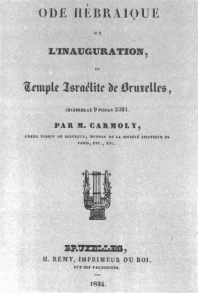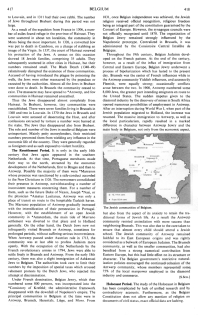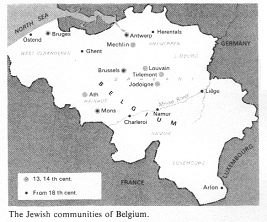Jews in Belgium 02: Napoleon and independent Belgium until 1933
Austrian rule - French rule - Ashkenazi Jews coming - independence 1831 - religious freedom - split of Belgian Jewry - strong Yiddish community in Antwerp with diamond industry
from: Belgium; In: Encyclopaedia Judaica 1971, vol. 4
presented by Michael Palomino (2008)
Share:
The solution is the Book of Life with Mother Earth - www.med-etc.com
[Austrian rule 1713 - Napoleon and some Jewish rights 1794 - Ashkenazi Jewish influx and special taxes]
<When Antwerp passed under Austrian rule in 1713, the community was at last able to profess Judaism more openly. With the occupation of the Netherlands by the French revolutionary armies in 1794, Jews were able to settle freely in Brussels and Antwerp. From the early 18th century, there was also a slight immigration of Ashkenazi Jews to Belgium. The authorities took care to limit their numbers by the imposition of special taxes which aroused vehement protests by the Dutch Jews, who rejected this attempt at discrimination.
Under French domination, Belgian Jewry, which then numbered some 800 persons, was incorporated into the *Consistory of Krefeld; the administrative framework disappeared with the downfall of Napoleon's empire. The principal communities in Belgium at the time were in Antwerp, Brussels, Herentals, Liège, and Mons. From (col. 417)
[Independence 1831 with official recognition and religious freedom - recognition of the synagogue councils 1870]
1831, once Belgian independence was achieved, the Jewish religion received official recognition, religious freedom being an integral part of the constitution guaranteed by the Concert of Europe. However, the synagogue councils were not officially recognized until 1870. The organization of Belgian Jewry remained strongly influenced by the Napoleonic prototype. Centralized in Brussels, it was administered by the Consistoire Central Israélite de Belgique.
Encyclopaedia Judaica (1971): Belgium, Vol. 4, col. 419. Title page of a Hebrew poem on the inauguration of a Brussels synagogue by the chief rabbi of Belgium, Eliakim Carmoly, 1834. Jerusalem, J.N.U.L.
[Split of Belgian Jewry in the 19th century between Brussels and Antwerp - diamond industry with the Antwerp community - Yiddish character of the Antwerp community]
Throughout the 19th century, Belgian Judaism developed on the French pattern. At the end of the century, however, as a result of the influx of immigration from central and eastern Europe, Belgian Jewry underwent a process of bipolarization which has lasted to the present day. Brussels was the center of French influences while in the Antwerp community Yiddish influences, and accessorily Flemish, were equally strong; occasionally conflicts arose between the two.
In 1900, Antwerp numbered some 8,000 Jews, the grater part intending emigrants en route to the United States. The sudden impetus given to the diamond industry by the discovery of mines in South Africa opened numerous possibilities of employment in Antwerp.
After an interruption during World War I, when part of the Jewish population migrated to Holland [[probably because of the German invasion]], the increase was was resumed. The massive immigration to Antwerp, as well as the local particularism, rapidly resulted in a marked difference in character between Antwerp Jewry and the main body in Belgium, not only from the economic aspect, but also from the aspect of its anxiety to retain the traditional forms of Jewish life. As a result the Antwerp community resisted assimilation with more success than neighbouring Brussels. This was also due to the care taken to ensure that almost every child should attend a Jewish school.
The Jewish community of Antwerp remained faithful to its East European origins and was rightly considered as a bulwark of European Judaism. The Brussels community, as well as the smaller communities, had also benefited from a strong numerical contribution from eastern Europe, but this had little effect on its structure of character. The Belgian government's restrictive naturalization policies encouraged the continued cohesion of the Antwerp community, whose members represented some 75% of the local manpower employed in the diamond industry and commerce.
[S.SCH.]> (col. 418)
Sources
Encyclopaedia Judaica (1971): Belgium, vol. 4, col. 417-418
Encyclopaedia Judaica (1971): Belgium, vol. 4, col. 417-418
Č Ḥ ¦ Ẓ
ā ḥ ī ū ẓ
^
 previous
previous


